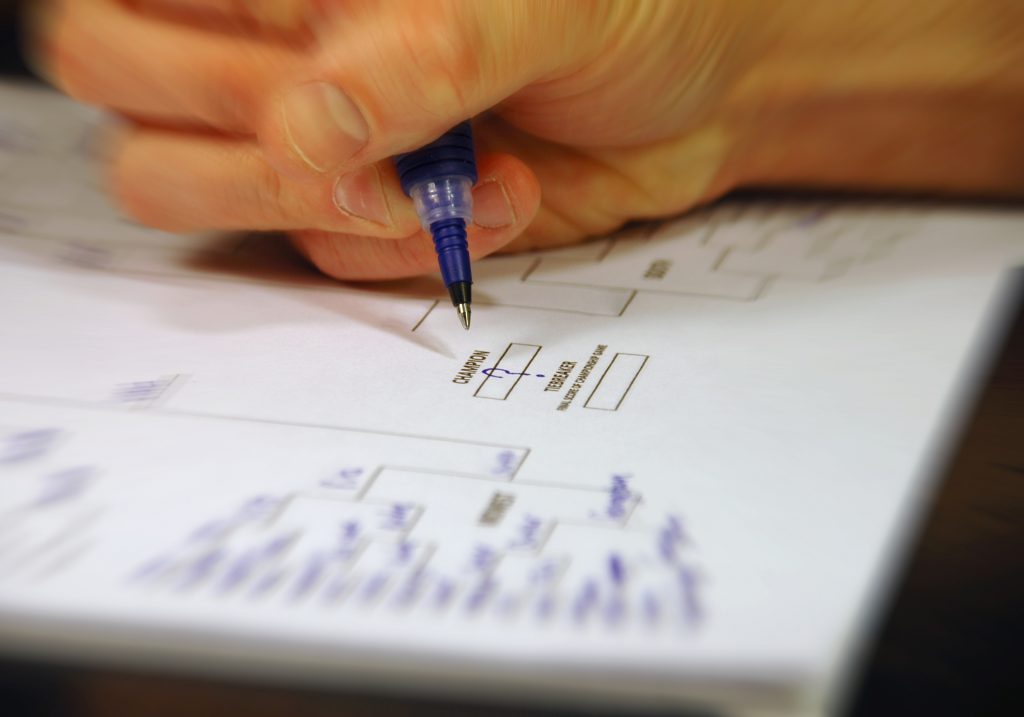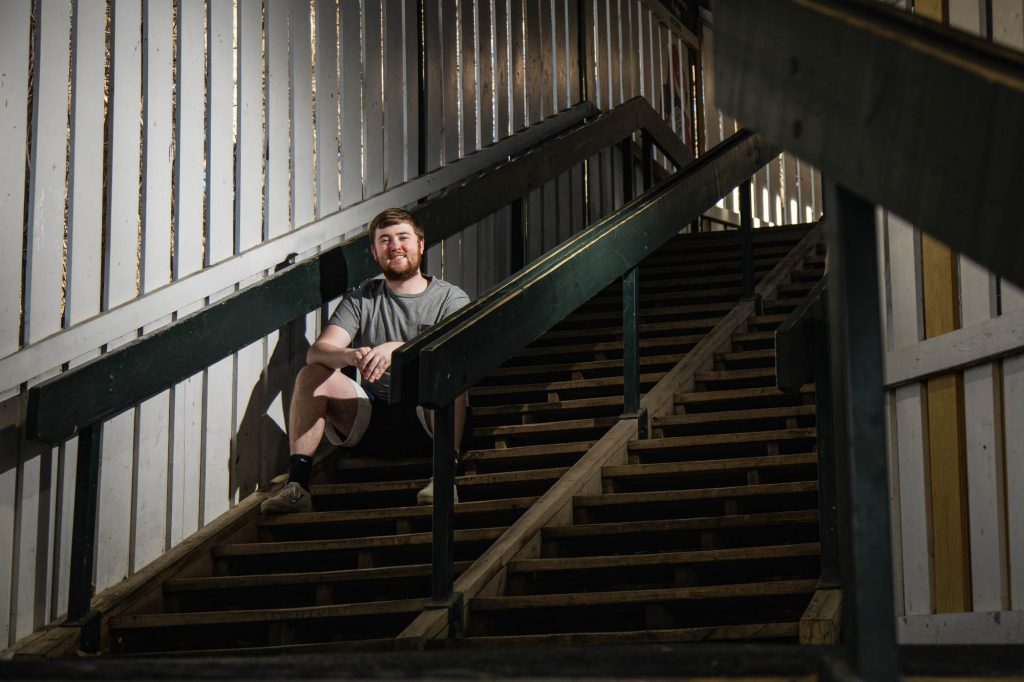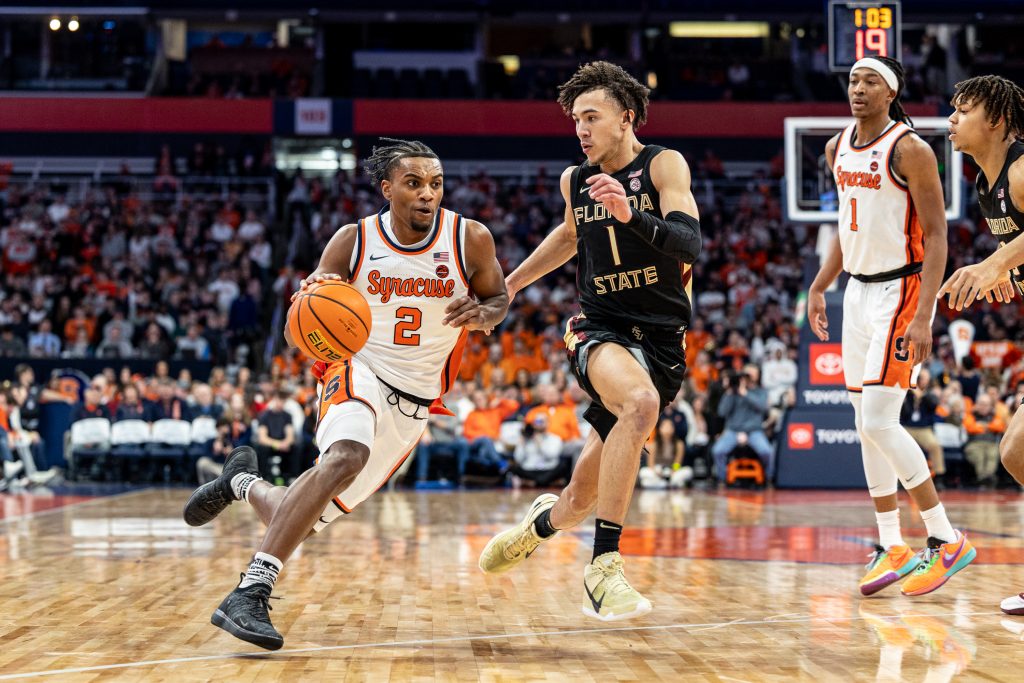A perfect March Madness bracket has never happened – and it never will
A perfect March Madness bracket has never happened – and never will
Though millions try each year, no one has ever come close to correctly guessing every game in the NCAA men’s basketball tournament.

As Hunter Geise ran up and down the 123 steps of Syracuse University’s Mount Staircase in a multi-colored tutu, his desire to ever make a sports bet again dwindled.
With each stair, Geise regretted betting on the most unpredictable tournament in sports – the NCAA men’s basketball tournament.
The sport analytics major whiffed on all his picks in the university’s sportsbook club — the only member of the 15-person group to do so. For his poor performance, he was sent to climb the stairs of embarrassment.
Remarkably, Geise wasn’t trying to make half-court shots with his bets.
“The picks that I would send in weren’t like they were terrible odds,” Geise said. “It was always under +300 odds. Half the time it was +200 or less.”
Geise was modest with his selections throughout the 2023 tournament during his sophomore year, only betting on close matchups like third-seed Gonzaga to beat fourth-seed UConn in the Elite 8.
Even so, he managed to airball. Over and over again. A student studying sports full-time couldn’t get a single pick right.
“It was just crappy luck,” he said.

But Geise isn’t alone in his struggles with trying to predict the outcome of the annual tournament often referred to as “March Madness.”
In 2023, the American Gaming Association projected that 56.3 million people would participate in bracket contests — a riddle no one has come close to solving.
The odds of a perfect bracket are 1 in 9,223,372,036,854,775,808, or one in 9.2 quintillions, or 263.
Shane Sanders, a professor of sports economics and analytics at SU, described the bracket as a decision tree that splits in two every game, creating a metaphorical fork for each matchup.
“There then become 63 forks but only one path is perfect,” Sanders said. “This is like randomly generating a binary string of 63 digits and then guessing the randomly generated string perfectly.”
That number — 9.2 quintillion — is a little skewed, however. Sanders added that through modeling, a person could significantly increase the odds of perfection.
“If you can model team strengths such that you are 60 percent sure of the winner in each game,” he said. “For example, the odds of a perfect bracket rise to (3/5)^63 or 1 in 94.7 trillion.”
By taking it a step further and creating a model where you’re 90% confident in the winner of each matchup, the odds are only 1 in 763 million.
“Things begin to get probable on the order of a national lottery if you have a game pick certainty in the high 0.7 range,” Sanders said. “Things start to get probable on the order of a local charity raffle if you have a game pick certainty of 0.9 or greater.”
But not everyone is this optimistic. Ryan Hammer, a TikTok content creator with more than 100,000 followers who has committed his page to college basketball and the bracket, gave a firm “No” to the thought he’d see a perfect bracket in his lifetime.
After extensive research, it’s hard to disagree with him.
Any research into trends from the last three years of the NCAA men’s basketball tournament is almost entirely useless. There is no way to find any leverage. The one piece of consistent data is the most important for winning your bracket pool – choosing a champion.
Each of the last 23 national champions (since 2000) have shared the following characteristics: started 8-2 or better, started 15-5 or better, had a winning streak of five or more games before the tournament, improved on their preseason ranking in the AP Poll or stayed the same, had a scoring differential of plus-7.0 or better, didn’t lose the first game of their conference tournament and joined four or more teams from their conference in the tournament.
Using those metrics the field of 68 shrank to eight for last year’s tournament, including the eventual champion, UConn. But despite those trends, the best data could do was provide a 12.5% chance of choosing the correct winner. And even if you selected the right one, that only means you got six games right. There’s still another 57 to go.
Data on the Final Four can make the unlikely achievement a little more obtainable.
Getting these four teams right would be predicting 16 games correctly. Every Final Four since 2010 (13 years) has had each of the following: no team seeded 12 or higher, at least one team with an “A” in its name, at least two teams with a head coach that has an “I” in their name, at least one team that won their conference tournament, at least one team that finished with a sub-80% winning percentage and at least one that failed to reach 6-0 to start the season.
While those statistics are strictly correlational and not built on anything quantifiable, they hold up well.
Daniel Gordon, a first-year student in Northeastern University’s Khoury College of Computer Sciences, spoke about the odds of getting last year’s Final Four correct.
Using combination principles, Gordon was able to drop the number of possible combinations from 635,375 to a little more than 300,000 simply by requiring one team to have an “A” in their name. After throwing in the four other criteria, Gordon said, “There are roughly 7,000-7,500 combinations.”
Using this method, one of the most unlikely Final Fours ever still could’ve been forecasted; though it’s still tough to pick the right one out of 7,500. Even in a historical year where no first, second, or third seeds made the Final Four, the first of its kind, the data held up.
But the part that research cannot explain — and prohibits perfection — is the existence of fate.
TikTok’s Hammer, who believes in using bracket statistics, said some outside elements simply cannot be predicted.
In 2023 it was 15th seed Princeton’s destiny. The year prior it was Saint Peter’s – the first 15th seed to ever make the Elite Eight. In 2018 when the University of Maryland-Baltimore County knocked off first-seeded Virginia to become the first 16th seed to ever win a Round of 64 game, it was their turn.
“Destiny is such a true thing,” Hammer said.
What makes the concept of perfection so absurd is the lack of consistency in the first round. There was virtually no predictable reason why first-seed Purdue lost to 16th-seed Fairleigh Dickinson in the 2023 tournament. Or why 15th seed Princeton toppled not only Arizona but Missouri as well that year.
There are no trends for these low seeds making history year after year. All research can do is limit the damage.
Even if the bracket worked in your favor and didn’t have historical upsets — as the 2015 and 2019 tournaments had — there’s still an element of luck.
The matchup between the teams seeded eight and nine is a true toss-up and there isn’t an ounce of regularity in these games. All-time, nine seeds hold a 78-74 edge, by far the smallest margin between seeds. In ESPN’s 2023 Men’s Tournament Challenge, more than half the 20 million brackets entered were eliminated from perfection after the first game concluded, eight-seed Maryland vs. nine-seed West Virginia.
To add insult to injury, the data can be shallow at times.
“I could imagine a scenario where there’s a team that fulfills all the data requirements, but just historically is not a good team,” Gordon said.
A prime example of this was the Tennessee Volunteers in last year’s tournament. While the Vols did possess the potential to make the Final Four in terms of data, the loss of starting point guard Zakai Ziegler and an underwhelming 5-7 record to close out the regular season ruined them.
Not to mention the sport is moving further away from the possibility of perfection each year due to two major aspects: the transfer portal — and its right-hand man, NIL — and the fact people are simply better at basketball.

Gone are the days when every player sticks with the school that recruited them. Schools like FAU, which retain a homegrown approach, are becoming anomalies at this point. Instead, players jump around the country as they please, allowing programs to reach new heights. The Kansas State Wildcats managed to reach the Elite 8 last season using a rotation consisting of only one player — Dorian Finister — who began his college career at KSU.
Countless schools are applying this same approach, says Anthony Altieri, the founder of Hoop Scoop Media, home to a database that tracks every player who enters the transfer portal.
More than 20 Division I programs — including 2021 NCAA Tournament six-seed BYU — are currently subscribed to Altieri’s database, where coaches can view the list of around 2,000 players in the portal. Over 40% of all DI players on scholarship were looking for a new home this past offseason, Altieri said.
While some players in the portal are strictly looking for more playing time, many are searching for something bigger.
“People want to make more money somewhere else," Altieri said. "People want to get the best deal they can.”
Money talks, as always, and NIL deals are the way schools are building their teams.
Programs like Kansas State, which is in a powerhouse conference and has the money to throw out deals to transfers, can capitalize on this phenomenon. The playing field in college basketball is closer to even with each player that enters their name in the portal.
Big-time schools aren’t the only ones climbing the ranks courtesy of the transfer portal, though.
Rocco Miller, a bracketologist whose projected field of 68 outscores the “experts” like ESPN’s Joe Lunardi and NCAA’s Andy Katz nearly every year, thinks the middle of the pack is on the rise too.
“You can build a team on the fly — obviously you probably want to put some money into that — that can turn around and compete next year, and actually make a Final Four,” Miller said.
There are programs all around the country that began the 2022 offseason with not a single player on scholarship. The Tulsa Golden Hurricanes, a member of the American Athletic Conference, were in this boat.
If a situation like this had happened before the transfer portal era, Tulsa would be doomed. But because of the portal, they are a middle-tier team in the AAC after just two seasons.
“It’s all realistic now," Miller said. "That was literally impossible just like five years ago."
And along with the top-tier talent getting lured for financial reasons, the talent gap itself is shrinking.
“Players are playing up to their talent level. And there’s more talent,” Altieri said.
That is why last year saw a Final Four without any top seeds – fifth-seed San Diego State is not as far from top-seeded Alabama as it used to be, thanks in part to the portal.
Many of these mid-major schools are on almost equal footing with the top programs because of the ability to transfer.
“If it’s a Michigan State kid and he realizes, ‘Hey I might not be good at a Big Ten level, but I can go to George Mason and I’ll probably be their best player,’ that’s enough reason for him to go to George Mason,” Miller said.
Then the flip side happens. A player will leave a smaller school and play up in a higher conference, thus creating something Miller called the “ecosystem” of college basketball.
And it’s healthier than ever – meaning the 1 in 9.2 quintillion chances of perfection are almost certainly a guarantee.
